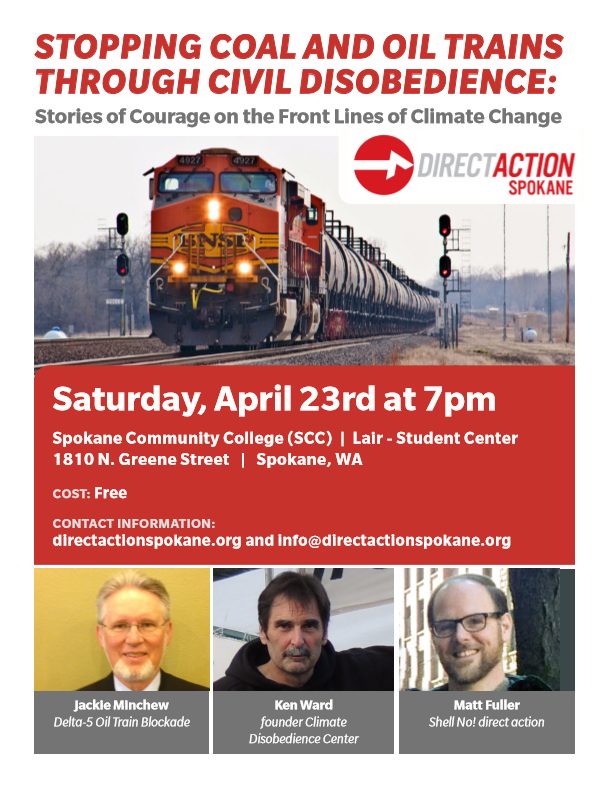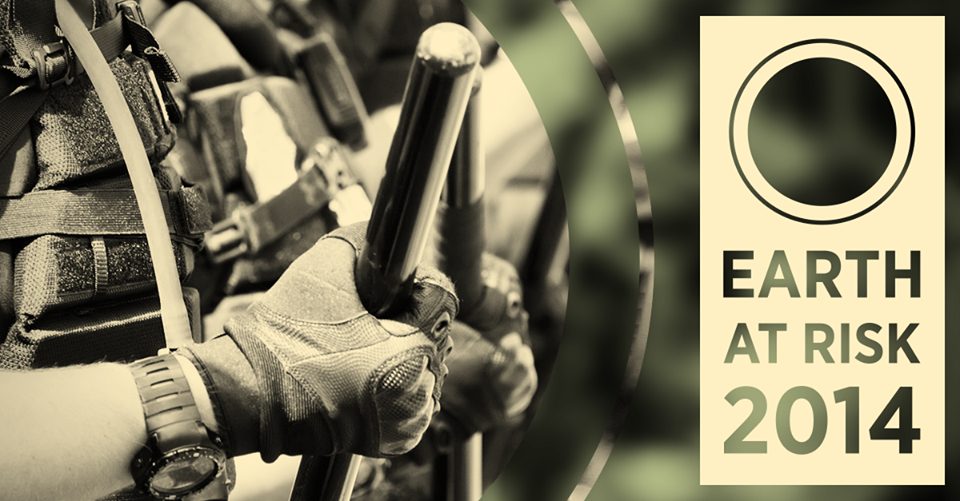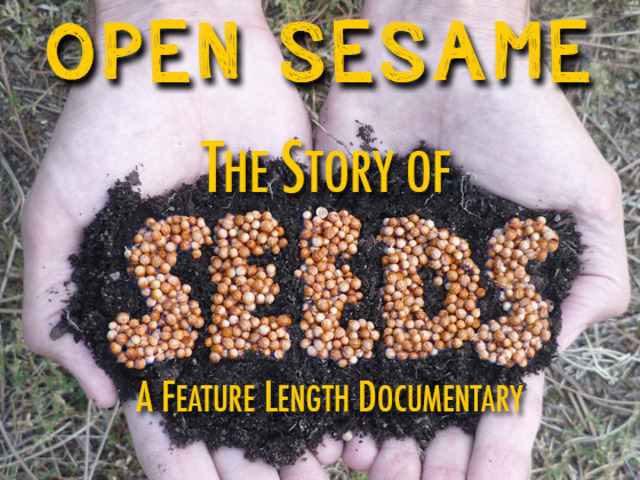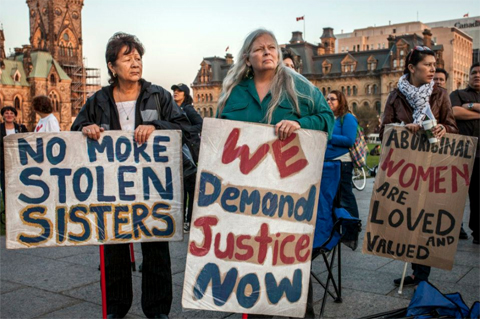
by Deep Green Resistance News Service | Apr 16, 2016 | Climate Change, Education, Strategy & Analysis
Stopping Coal and Oil Trains Through
Civil Disobedience: Stories of Courage
on the Front Lines of Climate Change
Saturday, April 23rd at 7pm
Spokane Community College – Lair Student Center
Free admission
Featured speakers:
Event host – Direct Action Spokane
by DGR News Service | Dec 19, 2014 | Culture of Resistance, Education
Will Falk / Deep Green Resistance
originally published at Generation Alpha
The proper cure requires the proper diagnosis.
On November 22 and 23, the Fertile Ground Environmental Institute offered the proper diagnosis for the ecological crises we all face to over 700 attendees at Earth at Risk 2014. Focusing on environmental and social justice, the conference brought together seemingly disparate voices to weave together diverse perspectives to offer a comprehensive response to global destruction. The keynote speakers were Vandana Shiva, Alice Walker, Chris Hedges, Thomas Linzey, and Derrick Jensen.
Shiva detailed how multi-national corporations like Monsanto and DuPont are using genetically modified organisms (GMO) to undermine local communities’ ability to produce their own food. Walker shared her experiences as a Pulitzer Prize winning author to give an artist’s perspective for the necessity of solidarity with women. Hedges drew upon nearly two decades as a foreign war correspondent to argue for the moral imperative of resistance to topple industrial civilization. Linzey, an attorney, illustrated how citizens come to him asking for help drafting ordinances against fracking and are converted into revolutionary cadre when they learn through the legal system that they do not live in a democracy. Jensen addressed the question “Why are so few of us fighting back?” with an explanation that most of us in this culture are suffering from complex post-traumatic stress disorder.
Time is short and Earth at Risk displayed the appropriate urgency in the face of total environmental destruction. Studies around the world confirm what we feel in our hearts to be true. A recent study by the World Wildlife Fund and the Zoological Society of London shows that half the world’s population of wild animals has died off since 1970. This is consistent with the findings of the University College of London showing insect populations crashing 50 percent in the last 35 years. Human destruction is necessarily implicated in the death of the natural world. We know, for example, dioxin – a known carcinogen – is now found in every mother’s breast milk.
A mere conference is insufficient to stop the madness, but Earth at Risk offered the most complete examination the movement has seen to date offering six panel discussions to go with the five keynote speakers. The first day was devoted to sustainability and featured panel discussions titled Colonization and Indigenous Life, Indicators of Ecological Collapse, and Building Resistance Communities. The second day was devoted to social justice with panels covering Capitalism and Sociopathology; Race, Militarism, and Masculinity; and Confronting Misogyny.
Personal Reflections
In a world gone mad, there are simply too few resisters struggling on. This is one of the reasons we are losing so badly. I left Earth at Risk feeling that patriarchy, colonialism, and capitalism are the most serious threats to a living world. To save the world, alliances must be built on all fronts. While our movements remain relatively small, strength can be maximized in this way.
Earth at Risk’s speakers illuminated opportunities for coalition building and pointed out weak spots in the system ripe for targeting. There were too many highlights to document in one article, but my favorite moments included native Hawaiian filmmaker Anne Keala Kelly’s stinging remarks on the colonization of Hawaii and implorations for real decolonizing help from the mainland during the Colonization and Indigenous Life panel. Fighting for Hawaiian sovereignty would necessarily involve undermining the United States’ military presence there. Hawaii is the site of the United States’ Pacific Command that polices over half the world’s population.
During the Building Communities of Resistance panel, Mi’kmaw warrior Sakej Ward described how native warrior societies protect land bases so they may support the next seven generations. He drew attention to the 500 years of experience North American indigenous peoples have in resisting colonization and offered this experience as a valuable resource.
I was deeply moved by the entire conversation during the Race, Militarism, and Masculinity panel where military veterans Kourtney Mitchell, Vince Emanuele, Stan Goff, and Doug Zachary called on men to topple the patriarchy, stop rape, and support women with actions instead of words.
I attended the conference as a director of the Vancouver Island Community Forest Action Network (VIC FAN) in support of Unist’ot’en clan spokeswoman Freda Huson and Wet’suwet’en hereditary chief Dini Ze Toghestiy who spoke on the Building Communities of Resistance panel about their experiences at the Unist’ot’en Camp. The Unist’ot’en Camp occupies the unceded territory of the Unist’ot’en Clan of the Wet’suwet’en people and is a pipeline blockade sitting on the proposed routes of 17 fossil fuel pipelines in central British Columbia.
My visits to the Unist’ot’en Camp have taught me the strength in connecting the rationales for different social and environmental movements under one banner. It has also taught me how to think strategically. The Camp, as just one of many examples present at Earth at Risk, incorporates principles of indigenous sovereignty and environmentalism to bring activists from both communities together to combat imperialism and fossil fuels. More importantly, perhaps, the Camp demonstrates how a handful of volunteers can effectively neutralize huge, multi-corporate projects by focusing physical strength on chokepoints in industrial infrastructure. From a strategic perspective, the military-industrial complex wrecking the world runs on fossil fuels. Corking the fossil fuels would be a grievous blow to the dominant culture’s ability to continue business as usual.
Additionally, I am a member of the worldwide social and environmental justice organization Deep Green Resistance (DGR) based on the strategy developed by Lierre Keith, Derrick Jensen, and Aric McBay in the book Deep Green Resistance. DGR played a large role organizing the event. Keith brilliantly points out that, “Militarism is a feminist issue. Rape is an environmental issue. Environmental destruction is a peace issue.”
Hearing Kourtney Mitchell explain how his education in pro-feminism enabled to him to overcome the inherently abusive training he received as an infantry soldier in Georgia’s National Guard proved this to me. When Derrick Jensen was confronted for describing the destruction of the natural world in terms of rape and sexual violence and he refused to stop making the connection on grounds that both hinge on men’s perceived entitlement to violation, I understood that radical feminists and radical environmentalists were logical allies. Finally, hearing Richard Manning explain how dire the world’s lack of topsoil has become drove the point home that those of us sick of war would do well to defend the land’s ability to support food.
Finally, the Earth at Risk 2014 website promised to craft “game-changing responses to address the converging crises we face.” The conference successfully fulfilled its promise. The truth is we simply do not have the numbers to mount an effective resistance movement without forming coalitions between groups serious about stopping the murder of the planet and other humans.
I wrote earlier that a conference is insufficient to stop the madness. This is still true, but Earth at Risk 2014 accurately analyzed the world’s sicknesses and gave us a treatment plan to work from. Now, it’s time for all of those fighting so hard in our various causes to link up in solidarity to bring down the patriarchy, stop capitalism, and undermine the colonialism that is killing humans and obliterating the natural world.

by Deep Green Resistance News Service | Nov 17, 2014 | Culture of Resistance, Education
By Fertile Ground
San Francisco, November 22nd-23rd
Global warming. Racism. Sexual Violence. Inequality. War. Species extinction. What are the links between these issues? And how can we move towards victory? An upcoming conference seeks to bring these issues together and answer these critical questions.
“All of the issues we face come from the same culture of extraction,” says event organizer Saba Malik. “They are driven by an urge to exploit. That is what we need to confront.”
Earth at Risk: The Justice and Sustainability Conference is being organized by a grassroots non-profit called Fertile Ground Environmental Institute. The event will feature presentations from radical activists and thinkers on the frontlines of struggle.
Participating speakers and organizations include: Vandana Shiva, Alice Walker, Chris Hedges, Chief Caleen Sisk, Derrick Jensen, Unist’ot’en Camp, Indigenous Women Against the Sex Industry, Thomas Linzey, Sakej Ward, Gail Dines, Dahr Jamail, Iraq Veterans Against the War, Veterans for Peace, Diane Wilson of CODEPINK, and many more.
Most environmental and social justice conferences are driven by corporate agendas and seek appeasement. Earth at Risk is different: it’s a grassroots gathering of people who reject greenwashed solutions and seek revolutionary change.
“Through the green economy an attempt is being made to technologize, financialize, privatize and commodify all of the earth’s resources and living processes,” says keynote speaker Vandana Shiva. “But the growth of the market cannot solve the very crisis it creates.”
Time is short. Indicators of environmental health and cultural morality are heading in the wrong direction. We need all hands on deck, but it’s hard to know where to start. Earth at Risk is a beginning. Join us at the event, and learn the information and the strategies that we need to turn this struggle around.
From Fertile Ground: http://www.fertilegroundinstitute.org/press-release—earth-at-risk-2014.html
Will you be there?
Read Will Falk’s report back on the event, Earth At Risk 2014: Proper Diagnosis

by DGR News Service | Oct 11, 2014 | Education
Our planet is being murdered. Mountains are falling. The oceans are dying. The climate itself is bleeding out and it may be beyond repair. Industrial civilization has entered its thrashing endgame. Technology can’t fix it and shopping—no matter how green—won’t stop it. And we are out of time.
The environmental movement has severely truncated its strategic thinking by insisting on education, consumer choices, and legislative initiatives as the only options for action. None of these can address the scale of the emergency facing our planet.
To save this planet, we need a serious resistance movement that can bring down the industrial economy. Authors Derrick Jensen and Lierre Keith with filmmaker Carson Wright are producing a film that will make the case for that movement. On the Side of the Living starts where the environmental movement leaves off: civilization can never be sustainable and is ultimately incompatible with life. People of courage and conscience are now stranded between moral agony and moral agency: the only certainty is that our one and only home will soon be a bare rock if we do nothing. Within that terrible urgency, the film confronts the possibility—and possible necessity—of principled, militant resistance.
$10,000 will see On the Side of the Living to completion. Go to https://www.indiegogo.com/project/preview/0c27882b to find out more and donate. If you love this planet, please give what you can. Your contributions will help us with film equipment, design, and production costs, as well as transportation expenses so we can deliver aesthetically striking footage with interviews from the movement’s most charismatic leaders.
Those in power are using their control over the culture industry to churn out story after story, book after book, film after film seducing us to forget and encouraging the masses to snuggle back into the warm illusion of civilization. On the Side of the Living combats the lies of those in power. Your support will help us spread our message to a greater audience.
A film supporting principled, militant resistant movement will probably not be overwhelmingly popular with the mainstream population. On the Side of the Living’s message will most likely prevent it from receiving material support from traditional sources of funding like corporations or government grants. But, as so many resistance movements have proven – from the efforts of the women suffragists, to the IRA, and to the Movement for the Emancipation of Niger Delta – a committed group of militant resisters can win.
Funding for On the Side of the Living will be provided by grassroots supporters like you. Support for a serious resistance movement is growing and your support for this film will speed the momentum.
What can you do
– Donate money to make it happen
– share with your networks
– share on social media
– share promotional posters and other media
– organise a fundraiser
Go to https://www.indiegogo.com/project/preview/0c27882b to find out more.

by DGR News Service | Sep 6, 2014 | Agriculture, Education, Lobbying
By Norris Thomlinson / Deep Green Resistance Hawai’i
Open Sesame examines the importance of seeds to humans as the genesis of nearly all our domesticated foods. It details the tremendous loss in varietal diversity of our crops over the last century, due in large part to increasing corporate control over the seed market.
Farmers and gardeners in every region once had access to dozens of varieties of each vegetable and staple crop, finely adapted to the specific growing season, temperatures, rainfall patterns, insects, diseases, and soils of their area. With few people now saving their own seed, we’ve entrusted our food supply to a handful of seed companies selling the same handful of varieties to growers across the US. This will prove increasingly problematic as climate chaos increases divergence from climatic norms. We need a return to seed saving and breeding of numerous local varieties, each starting from a baseline adaptation to the specific conditions of each area. Diversity gives a better chance of avoiding complete catastrophic crop failure; this variety may yield in the heavy rains of one year, while that variety may succeed in the drought of the next.
The film shows beautiful time lapse sequences of seeds sprouting and shooting into new life. Even rarer, it shows people feeling very emotional about seeds, displaying extra-human connections we normally only see with domesticated pets, and hinting at the human responsibility of respectful relationship with all beings described by so many indigenous people. The movie highlights great projects from seed schools and the Seed Broadcast truck educating people on why and how to save seed, to William Woys Weaver and others within Seed Savers Exchange doing the on-the-ground work of saving varieties from extinction, to Hudson Valley Seed Library trying to create a viable business as a local organic seed company.
Civilization and Agriculture
Unfortunately, Open Sesame has an extremely narrow focus. Though it rightly brings up the issue of staple crops, which many people ignore in their focus on vegetables, it trumpets our dependence on grains, even showing factory farmed cattle, pigs, and chickens in an uncritical light. This assumption that humans need annual crops reveals an ignorance of agriculture itself as a root cause of our converging environmental crises. Even before industrialism accelerated the destruction and oppression, civilization and its cities, fed by organic agriculture, was eroding soil, silting up waterways, turning forests into deserts, and instituting slavery and warfare. Though the diminished diversity within our food crops should indeed cause concern, the far greater biodiversity loss of mass species extinctions under organic agriculture should spark great alarm, if not outright panic.
In one scene, the documentary shows a nighttime urban view of industrial vehicles and electric lights, bringing to mind the planetary destruction enacted by the creation and operation of these technologies. Beneath the surface, this scene contains further social and imperialistic implications of packing humans into artificial and barren environments. The residents of this scene are fully reliant on imported food and other resources, often stolen directly, and all grown or mined from land stolen from its original human and non-human inhabitants. But the film goes on to point out, without any irony, that all civilizations began with humans planting seeds, as if the only problem we face now is that industrialization and corporate control applied to agriculture threaten the stability of otherwise beneficial systems.
In a similar disconnect, Open Sesame proclaims the wonders of gardening, farming, and “being in nature” while showing simplified ecosystem after simplified ecosystem ― annual gardens and fields with trees present only in the background, if at all. As any student of permaculture or of nature could tell you, the disturbed soil shown in these human constructions is antithetical to soil building, biodiversity, and sustainability. The film describes seeds “needing” our love and nurturing to grow, positioning us as stewards and playing dangerously into the dominating myth of human supremacism. Such dependence may (or may not) be true of many of our domesticated crops and animals, but I think it crucial to explicitly recognize that in indigenous cultures, humans are just one of many equal species living in mutual dependence.
Though the documentary chose not to tackle those big-picture issues, it still could have included perennial polycultures, groups of long-lived plants and animals living and interacting together in support of their community. For 99% of our existence, humans met our needs primarily from perennial polycultures, the only method proven to be sustainable. The film could have chosen from hundreds of modern examples of production of vegetables, fruit, and staple foods from perennial vegetable gardens, food forests, and grazing operations using rotating paddocks. Even simplified systems of orchards and nutteries would have shown some diversity in food production options. Besides being inherently more sustainable in building topsoil and creating habitat, such systems rely much less on seed companies and help subvert their control.
Liberal vs Radical
The Deep Green Resistance Youtube Channel has an excellent comparison of Liberal vs Radical ways of analyzing and addressing problems. In short, liberalism focuses on individual mindsets and changing individual attitudes, and thus prioritizes education for achieving social change. Radicalism recognizes that some classes wield more power than others and directly benefit from the oppressions and problems of civilization. Radicalism holds these are not “mistakes” out of which people can be educated; we need to confront and dismantle systems of power, and redistribute that power. Both approaches are necessary: we need to stop the ability of the powerful to destroy the planet, and simultaneously to repair and rebuild local systems. But as a radical environmentalist, I found the exclusively liberal focus of Open Sesame disappointing. There’s nothing inherently wrong with its take on seed sovereignty; the film is good for what it is; and I’m in no way criticizing the interviewees doing such great and important work around seed saving and education. But there are already so many liberal analyses and proposed solutions in the environmental realm that this film’s treatment doesn’t really add anything new to the discussion.
A huge challenge I have with liberal environmentalism is its leap of logic in getting from here (a world in crisis) to there (a truly sustainable planet, with more topsoil and biodiversity every year than the year before.) Open Sesame is no exception: it has interview after interview of individuals carrying out individual actions: valuable, but necessarily limited. Gary Nabham speaks with relief on a few crop varieties saved from extinction by heroic individual effort, but no reflection is made on the reality of how much we’ve lost and the inadequacy of this individualist response. We see scene after scene of education efforts, especially of children. We’re left with a vague hope that more and more people will save their own seed, eventually leading to a majority reclaiming control over their plantings while the powerful agribusiness corporations just fade away. This ignores the institutional blocks deliberately put in place precisely by those powerful companies.
The only direct confrontation shown is a defensive lawsuit begging that Monsanto not be allowed to sue farmers whose crops are contaminated by patented GMOs from nearby fields. The lawsuit isn’t even successful, and the defeated farmers and activists are shown weary and dejected, but with a fuzzy determination that they can win justice if they keep trying hard enough. The film could instead have built on this example of the institutionalized power we’re up against and explored more radical approaches to force change. Still within the legal realm, CELDF (Community Environmental Legal Defense Fund) helps communities draft and pass ordinances banning things like factory farming, removing corporate personhood, and giving legal rights to nature within a municipality or county. Under such an ordinance, humans could initiate a lawsuit against agricultural operations leaching chemicals and sediment, on behalf of an impacted river. This radical redistribution of decision making directly confronts those in power and denies them the right to use it against the community and the land.
In the non-legal realm, underground direct attacks and aboveground nonviolent civil disobedience have successfully set back operations when people have cut down GMO papayas, burned GMO sugar beets, and sabotaged multiple fields and vineyards. The ultimate effectiveness of these attacks deserves a whole discussion in and of itself, but they would have been worth mentioning as one possible tactic for ending agribusiness domination of our food supplies.
In a perfect demonstration of the magical thinking that wanting something badly enough will make it happen, the documentary concludes with a succession of people chanting “Open sesame!” We’ve had 50 years of experience with this sort of environmentalism, long enough to know it’s not working. We also know that we, and the planet, have no time left to waste. We need to be strategic and smart in our opposition to perpetrators of destruction and in our healing of the damage already done. The Decisive Ecological Warfare strategy of Deep Green Resistance offers a possible plan for success, incorporating all kinds of people with all kinds of skills in all kinds of roles. If you care about the world and want to change where we’re headed, please read it, reflect on it, and get involved in whatever way makes the most sense for you.

by DGR News Service | Aug 5, 2014 | Education, Indigenous Autonomy, Male Violence
By No More Silence
As Indigenous peoples, working for justice for #MMIW is a process that starts within our own communities. The launch of this website is one example of the resurgence of community documentation as justice.
In April of 2013, No More Silence, Families of Sisters in Spirit and the Native Youth Sexual Health Network began what has become a long term vision for a community-led database documenting the violent deaths and disappearances of Indigenous women. It is our collective hope that the lives of Indigenous Two Spirit, lesbian, gay, bisexual, transgender, transsexual, queer, questioning, intersex, and asexual (LGBTTQQIA) will also be recognized as gender based violence also impacts these communities and is often invisibilized.
The website is available for viewing at: www.ItStartsWithUs-MMIW.com
FSIS, community partner on this initiative indicated that they “support a grassroots led community database because Indigenous people are first and foremost the experts in gathering data and information about missing and murdered Indigenous women”. The launch of this website is an outcome from many community conversations with impacted families and individuals affected by colonial gender based violence.
1 year later and still no justice…The purpose of the database is to our honour women and provide family members with a way to document their loved ones passing. As the one year anniversary of Bella Laboucan-Mclean’s death approaches the family has provided the first of many tribute pieces on the website, available to read at: www.ItStartsWithUs-MMIW.com/bella
According to Melina Laboucan-Massimo, “Our family still does not have answers from the Toronto Police about Bella’s death which is still listed as suspicious. We appeal to anyone with information to come forward with answers. We urge the Toronto Police to investigate her death as if Bella were part of their own family and not just another police statistic. This new website and database gives families like ours the ability to not only document the lives of our loved ones but also commemorate and celebrate their lives and achievements.”
As the search for answers persists, we continue to urge the Toronto Police Service to maintain their focus on the details surrounding Bella’s death as the family and larger community follow this case closely. We are honoured to have Bella’s story be the first tribute that is shared on the website as a way of recognizing her life and spirit.
We also call attention to Sonya Cywink, murdered in London, ON who’s family and community are preparing a memorial on the 20th anniversary of her passing and are also holding out hope that one day they will uncover the mystery surrounding her murder.
Krysta Williams of the Native Youth Sexual Health Network and community partner, “We know there are many other stories, families and anniversaries, this is just the beginning. We continue to build capacity within our networks to respond and support.”
For more information and background on #ItStartsWithUs please read “Supporting the Resurgence of Community-Based Responses to Violence” at: http://www.nativeyouthsexualhealth.com/march142014.pdf
No More Silence Media Contact:
Audrey Huntley
Phone:647-981-2918 Email: audreyhuntley@gmail.com
Bella’s Family Media Contact:
Melina Laboucan-Massimo
Phone:780-504-5567 Email: miyowapan@gmail.com
Native Youth Sexual Health Network Media Contact:
Erin Konsmo, Media Arts Justice and Projects Coordinator
Email:ekonsmo@nativeyouthsexualhealth.com
From Warrior Publications: http://warriorpublications.wordpress.com/2014/07/16/database-website-for-missing-and-murdered-indigenous-women/






